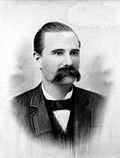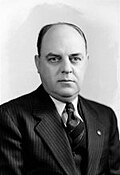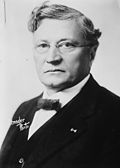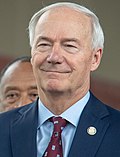List of governors of Arkansas
Wikimedia list article From Wikipedia, the free encyclopedia
Remove ads
The Governor of Arkansas is the head of the executive branch of Arkansas's state government and the commander-in-chief of the state's military forces.
Remove ads
List of governors
Governors of the State of Arkansas
Remove ads
Living former U.S. governors of Arkansas
As of February 2025, there were four former U.S. governors of Arkansas who are still living.
Remove ads
Notes
- James Miller was appointed territorial governor on March 3, 1819, the same date the bill organizing Arkansaw Territory was signed. However, to avoid the hot southern summer, he delayed his departure from New Hampshire until September, and took a non-direct route, finally arriving in the territory on December 26, 1819.[2] Robert Crittenden, secretary of the territory, served as acting governor while Miller was delayed.[3]
- Resigned citing poor health. At the time of his resignation, he had been absent from the territory for 18 months.[4]
- George Izard did not arrive in Arkansas Territory until May 31, 1825; Robert Crittenden, Secretary of the territory, acted as governor in his stead, though Crittenden himself was out of state when Izard arrived.[5]
- The office was vacant from November 22, 1828, until March 9, 1829. By the time notice of George Izard's death reached Washington, D.C., Andrew Jackson had been elected president, and the United States Senate refused to approve John Quincy Adams's choice for governor, preferring to wait until Jackson took office.[4]
- Pope arrived in the territory in May 1829.[7]
- Arkansas became a state on June 15, but Conway was not sworn in until September 13. Sourcing indicates that Fulton served until Conway's inauguration.[8]
- William S. Fulton served as governor until statehood, when he was elected to the United States Senate.[9]
- Data is sourced from the National Governors Association, unless supplemental references are required.
- According to the numbering generally used, acting governors are not numbered.[10]
- Most dates come from the Encyclopedia of Arkansas list of governors;[11] when differing, either the date was different in the actual articles on the governors and that agreed with other sources, or specific sourcing is supplied to explain the discrepancy.
- The office of lieutenant governor was created in 1864 and abolished in 1874. It was recreated in 1914, and was not filled until 1927. The amendment to the constitution creating the office was narrowly voted in by the electorate in 1914. The Speaker of the House declared that the measure had lost, because even though it had received the majority of the votes cast for that particular ballot measure, winning 45,567 to 45,206, it had not received the majority of votes cast across the whole election, determined by looking at the question on the ballot with the highest total number of votes for or against. On that ballot, this figure was 135,517 votes, so it was ruled that at least 67,758 votes in favor would have been required for the measure to pass, essentially counting blank votes as votes against. In 1925, it was discovered that a 1910 law amended this requirement such that only a majority of the votes on the specific question was required. Therefore, the 1914 initiative was declared to be valid.[12]
- Yell resigned to run for the United States House of Representatives, winning the election.[13]
- The National Governors Association says Drew succeeded Adams on November 5,[14] but the Encyclopedia of Arkansas[15] and contemporary news coverage[16] say November 9.
- Drew resigned due to the low salary he received as governor.[14]
- Roane was elected in a special election to fill the remainder of the term vacated by Thomas Stevenson Drew's resignation.[17]
- The National Governors Association says Rector succeeded Conway on November 15,[18] but the Encyclopedia of Arkansas[19] and contemporary news reports[20] say November 16.
- This term was shortened to two years due to the 1861 constitution moving the election schedule.[24]
- Some sources state Flanagin left office on April 18, 1864, but that was when Isaac Murphy was sworn in as provisional governor; Flanagin remained governor of the Confederate government-in-exile until May 26, 1865.[11]
- Flanagin fled Little Rock as it fell to Union forces on September 10, 1863, leading a largely inept government in exile in Washington, Arkansas until 1865. Murphy was elected provisional governor by a loyalist government set up after Union control of the state was established, taking office on April 18, 1864, causing a slight overlap in terms, though due to the collapse of the Confederate effort in Arkansas, Flanagin had no authority over the state.[26]
- The 1864 constitution was enacted during this term; however, it was drafted by the Union occupation, and had no effect on Flanagin's government. While term lengths remained at four years, a new election schedule was created, calling for elections in 1864.[27]
- Clayton resigned to take an elected seat in the United States Senate. He had delayed his resignation to prevent Lieutenant Governor Johnson from succeeding him; party machinations led Johnson's resignation and acceptance of the office of secretary of state, so that Hadley, as president pro tempore of the senate, could act as governor for the remainder of the term.[29]
- Ozra Amander Hadley's first name is sometimes spelled "Ozro" in sources; it is unknown which is correct.[29]
- Baxter was removed from office for a short time due to the Brooks–Baxter War.[31]
- Sources disagree on when Little resigned. The Encyclopedia of Arkansas says February 7, but the National Governors Association and a book by University of Arkansas Press[40] say February 11. Due to wider use, February 11 is the date used here.
- Little resigned after suffering a nervous breakdown soon after taking office.[41]
- As president of the senate, Moore acted as governor until the legislature adjourned,[42] at which time a new president pro tempore of the senate was chosen, Pindall, who acted as governor until his senate term expired.[43] For the remaining three days of the gubernatorial term, Martin, the new president pro tempore of the senate, acted as governor.[44]
- Robinson resigned to take an elected seat in the United States Senate.
- Oldham acted as governor for six days before a new president of the senate was elected.[46] The new president, Futrell, acted as governor[47] until Hays was elected in a special election to fill the remainder of the term.[48] Conflict over whether or not Futrell could succeed Oldham as acting governor led to the Arkansas Supreme Court ruling that he could.[49]
- Sources disagree on whether Brough succeeded Hays on January 10 or January 11; a contemporary source states January 10,[52] so this list uses that date.
- Sources disagree on whether McRae succeeded Brough on January 11 or January 12; a slim majority of sources say January 12.[53]
- Martineau resigned to be a judge on the United States District Court for the Eastern District of Arkansas[55]
- Bumpers resigned to take an elected seat in the United States Senate.
- Pryor resigned to take an elected seat in the United States Senate.
- Represented the Democratic Party.
- Clinton resigned in preparations to become President of the United States on January 20, 1993.
- Tucker resigned after being convicted of mail fraud in the Whitewater scandal;[59]
- Represented the Republican Party.
Remove ads
References
Wikiwand - on
Seamless Wikipedia browsing. On steroids.
Remove ads















































